How to design an Ice Plant ? Ice from Maximum Efficiency Plant
Chilling Designs: Crafting an Ice Plant
Designing an ice plant can be a complex process that requires careful planning and consideration of several factors, such as the required ice production capacity, the type of ice to be produced, the available space, and the budget.
We will discuss general steps that you can follow to design an ice plant.
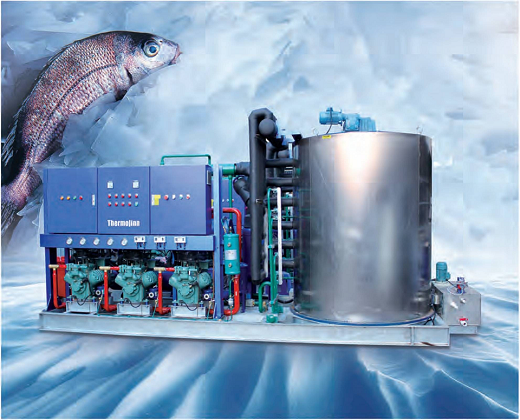
Introduction to Ice Plant Design
Expected Demand of Ice
Type Of Ice Needed
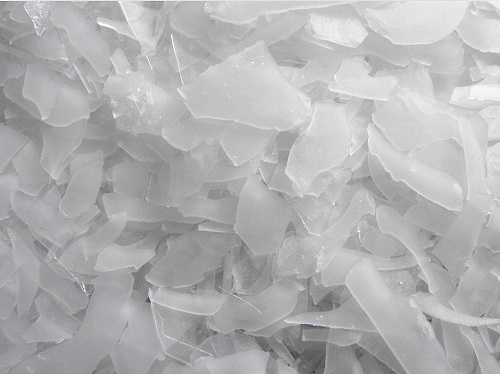
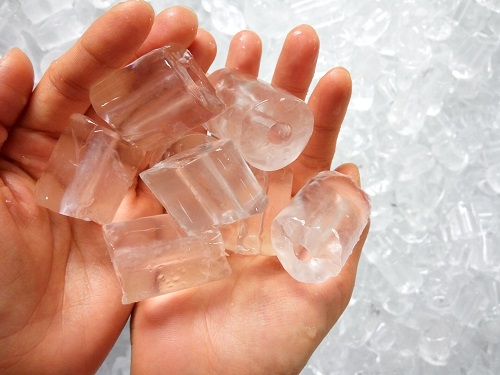
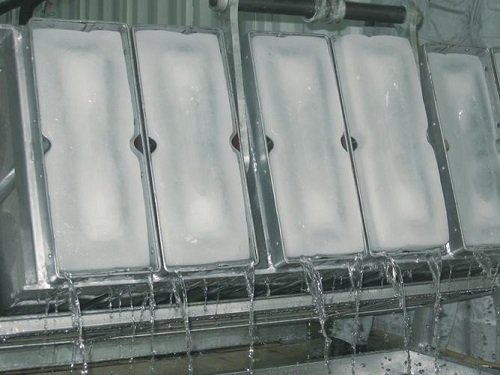
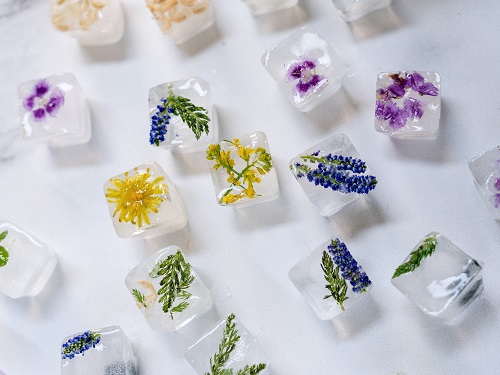
Refrigeration System Type & Design
The refrigeration system is a critical component of an ice plant, as it is responsible for creating and maintaining the necessary temperature conditions for ice production.
When designing the refrigeration system, factors such as the type of refrigerant used, the compressor capacity, and the cooling tower design must be taken into account.Water Supply and Treatment
Location and Climate Considerations
Space Required for Setting-up Ice Plant
Selection of the Equipments
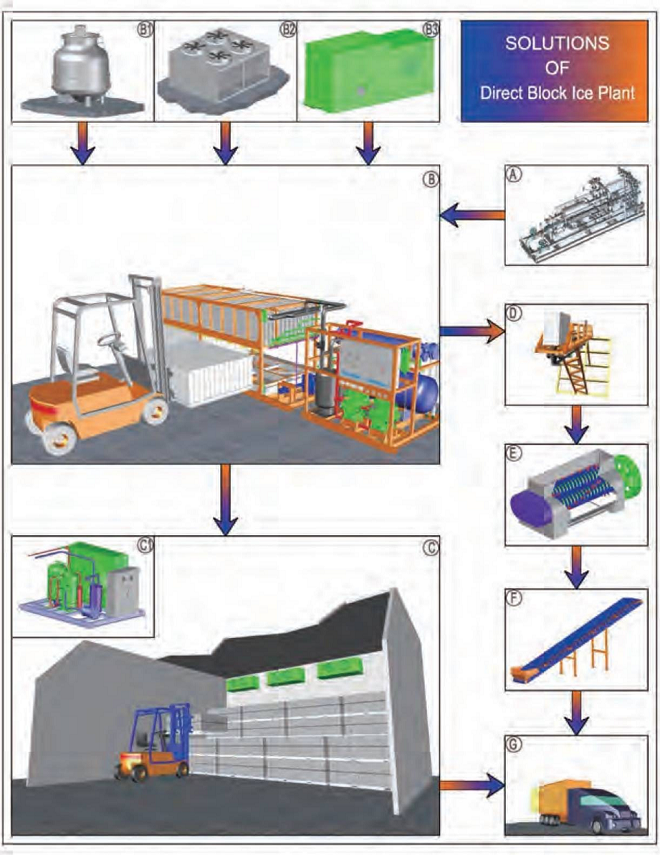
Direct Cooling Block Ice Plant
A: RO system
B: Direct cooling block ice plant
Bl: Cooling tower
B2: Air-cooled condenser
B3: Evaporative-cooled condenser
C: Ice storage
Cl: Refrigeration unit for ice storage
D: Block ice lifting conveyor
E: Block ice crusher
F: Crawler conveyor
G: Cold chain van
Direct cooling block ice plant (B) can adopt three cooling methods, respectively are cooling tower system (Bl), air cooled condenser (B2), evaporative-cooled condenser (B3).
After ice block forms, the filling ice plate will be lowered down to the ground. Forklift can take the ice on the filling ice plate to the ice storage (C) very quickly and by replacing another filling plate to continue making ice.
When forklift moves ice, buckle rubber strip around the ice on the filing plate so that ice will not fall from it. Ice in the ice storage also could be taken away promptly by forklift to the cold chain van (G).
Direct cooling ice block also can be lifted via lifting conveyor (D) to the ice crusher (E), and then the crushed ice will be sent to the packing machine conveyed by crawler conveyor (F). After packaging, ice can be loaded into the cold chain van (G) for distribution.
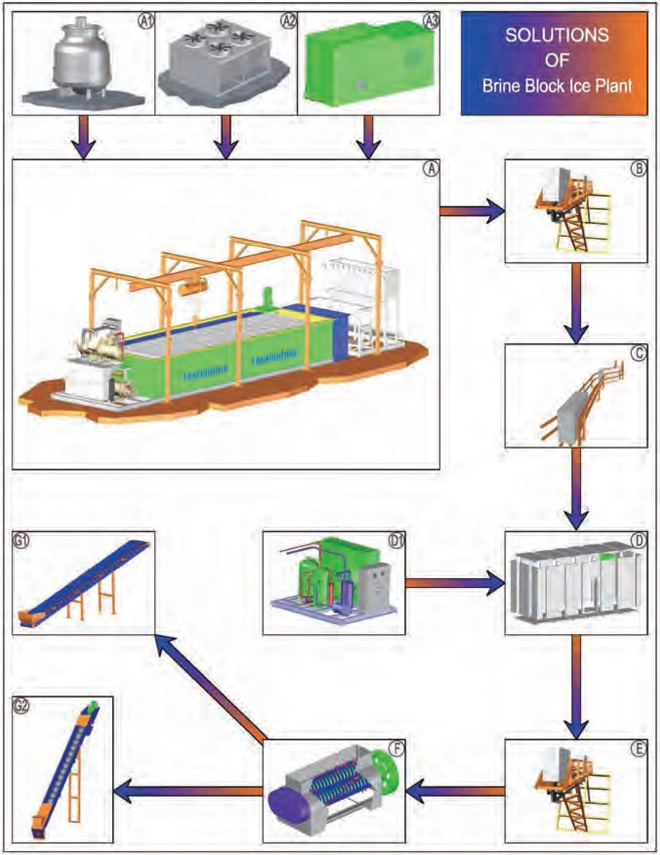
Brine Cooling Block Ice Plant
A: Brine system block ice machine
Al: Cooling tower
A2: Air-cooled condenser
A3: Evaporative condenser
B: Block ice lifting conveyor
C: Block ice sliding chute
D: Ice storage
DI: Refrigeration unit of ice storage
E: Block ice lifting conveyor
F: Block ice crusher
Gl: Crawler conveyor
G2: Screw conveyor
Brine system block ice machine (A) can adopt three cooling methods, respectively are cooling tower system (Al), air cooled condenser (A2), evaporative-cooled condenser (A3).
Ice blocks forms and then will be lifted by block ice lifting conveyor (B) to a certain height. Ice could slide from block ice sliding chute (C) to the inside of ice storage (D),the refrigeration unit (DI) keeps cold room temperature at around -8° C, so the ice will not melt. When need to use ice block, customer can rely on another block ice lifting conveyor (E) to deliver ice to the truck.
When crushed ice block is in need, customer can start ice crusher (F), the crushed ice will be transported through crawler conveyor (Gl) or screw conveyor (G2) to the truck.
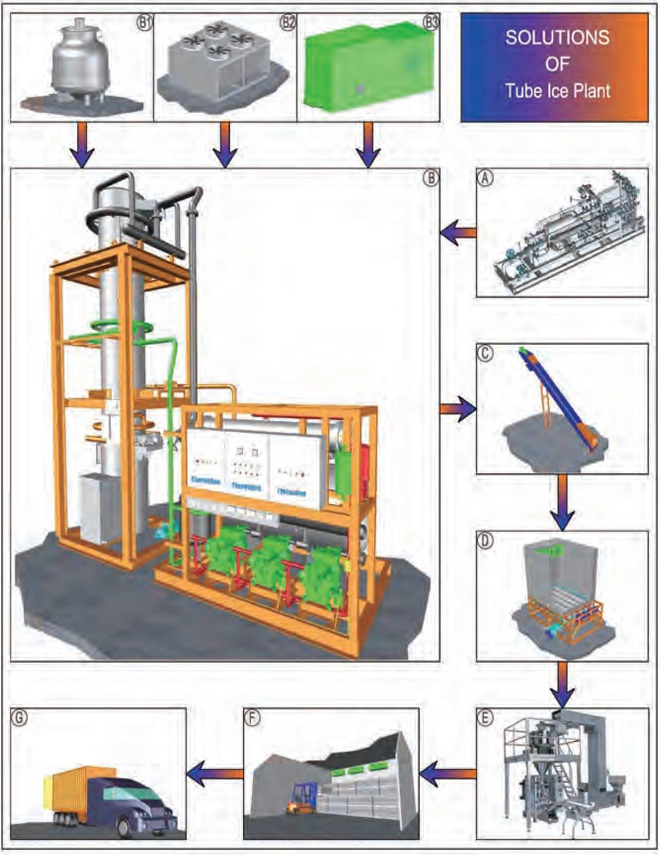
Tube Ice Plant
A: RO system
B: Tube ice machine
Bl: Cooling tower
B2: Air-cooled condenser
B3: Evaporative-cooled condenser
C: Screw ice conveying system
D: Screw type automatic ice storage
E: Multi-hoppers weighing and packing machine
F: Ice storage
G:Cold chain van
Ice could be directly eaten only after water be filtered and sterilized by RO system (A). Tube ice machine (B) has three cooling methods, respectively are cooling tower water-cooled system (Bl), air-cooled system (B2), evaporative-cooled system (B3).
After produced by tube ice machine, ice tube will be transported by screw ice conveying system (C) to screw type automatic ice storage (D).
Screw type automatic ice storage works only as tube ice buffer storage and could store 1/2 of daily capacity ice production, thus ice could be packed every 12 hrs. It can also automatically deliver ice to the multi-hoppers weighing and packing machine (E) for precise packaging then ice packs can be stacked on the pallets. Forklift takes the pallets to the ice storage (F), when ice is in need pallet can be transferred directly to the cold chain van (G).

Flake Ice Plant
A: Flake ice machine
Al: Cooling tower
A2: Air-cooled condenser
A3: Evaporative condenser
B: Common ice storage
C: Ice compactor
D: Rake type automatic ice storage
El: Blowing ice conveyor
E2: Screw ice conveyor
E3: Crawler ice conveyor
Flake ice machine (A) can adopt three cooling methods, respectively are cooling tower system (Al), air-cooled condenser (A2), evaporative-cooled condenser (A3).
Common ice storage (B) is usually installed under flake ice machine. The ice flake produced by ice machine falls off into ice storage from the bottom of flake ice machine evaporator. This plan fit for small capacity flake ice plant.
Rake type automatic ice storage (D) is installed under flake ice machine. The ice flake produced by ice machine falls off into ice storage from the bottom of flake ice machine evaporator. The ice layer can be automatically paved smoothly by the rake meanwhile the height of rake will be adjusted automatically according to the actual ice level, finally automatically conveys ice to the ice outlet etc. The outlet to the rake type automatic ice storage could connect to blowing ice conveyor (El), screw ice conveyor (E2), or crawler ice conveyor (E3) and send ice to needed place.
Flake ice can be directly put into ice compactor (C) to compress into various sizes of ice block.
Electrical and Plumbing System
Ice Storage and Packaging
Maintenance and Safety Protocols
Government Permits and Approvals
Professional Consultancy
An ice plant is a facility where ice is produced and stored for later use. The process of starting an ice plant involves several steps, which are as follows:
Install and set up the necessary equipment: You will need to install and set up the ice-making machine, water treatment system, refrigeration system, and storage containers.
Ensure the water source is clean and of good quality: The quality of water used in the ice-making process is essential, so you must ensure that the water source is clean and of good quality. If necessary, install a water treatment system to purify the water.
Fill the ice-making machine with water: Fill the machine's water reservoir with clean water, making sure not to overfill it.
Turn on the machine: Once the machine is filled with water, turn it on and allow it to run for several minutes until the first batch of ice is produced.
Check the ice for quality: Check the ice for size, shape, and clarity. If the ice is not of good quality, adjust the machine's settings accordingly.
Harvest the ice: Once the ice is produced, use a scoop or shovel to harvest it from the machine and transfer it to the storage containers.
Store the ice: Store the ice in a clean and dry place, such as a freezer or insulated storage container, until it is ready to be used.
It is important to follow all safety protocols when starting an ice plant, including wearing protective gear and following proper maintenance and cleaning procedures.
The structure of an ice plant can vary depending on its size, capacity, and the specific equipment used. However, a typical ice plant generally includes the following components:
Ice-making machine: This is the core component of the ice plant, where the ice is produced. The ice-making machine can use different methods to freeze water, such as air cooling, water cooling, or evaporative cooling.
Water treatment system: The water used in the ice-making process needs to be clean and free from impurities. The water treatment system filters and purifies the water, removing any contaminants that could affect the quality of the ice.
Refrigeration system: The refrigeration system maintains the temperature inside the ice-making machine, allowing the water to freeze into ice. It also keeps the ice storage containers at a low temperature, preventing the ice from melting.
Ice storage containers: Once the ice is produced, it is stored in insulated containers until it is ready to be used. The storage containers can be of different sizes and types, depending on the amount of ice produced and the storage requirements.
Conveyors and transport systems: Conveyors and transport systems are used to move the ice from the ice-making machine to the storage containers, as well as to transport the ice to the point of use.
Control systems: The ice plant's control systems monitor and control the various components of the plant, such as the refrigeration system, water treatment system, and ice-making machine. They ensure that the plant operates efficiently and safely.
Electrical and plumbing systems: The ice plant also requires electrical and plumbing systems to power the equipment and transport water and other fluids.
The structure of an ice plant can also include additional components, such as water storage tanks, ice crushers, and packaging machines, depending on the plant's specific needs and operations.
An ice plant typically consists of several components and pieces of equipment, which work together to produce and store ice. The main components and equipment in an ice plant include:
Ice maker: The ice maker is the heart of the ice plant and is responsible for producing ice in large quantities. It uses various methods to freeze water, such as air cooling, water cooling, or evaporative cooling.
Water treatment system, Refrigeration system, Ice storage containers, Conveyors and transport systems, Ice crushers and dispensers, Packaging machines, Electrical and plumbing system, Control systems, the specific components and equipment in an ice plant can vary depending on its size, capacity, and the type of ice produced.
The process of making an ice plant involves several steps, which include:
Design: The first step in building an ice plant is to design the plant layout and select the equipment to be used. The design process takes into consideration factors such as the amount of ice to be produced, storage requirements, and the type of ice to be produced.
Site preparation: The site for the ice plant needs to be cleared and prepared for construction. This may involve excavation, grading, and the installation of drainage systems.
Foundation construction: The foundation is constructed to support the ice plant's structure and equipment. The foundation must be able to withstand the weight of the equipment and the ice produced.
Building construction: The ice plant's building is constructed, which can be made of various materials, including concrete, steel, or prefabricated panels. The building must be insulated to maintain a low temperature and prevent the ice from melting.
Equipment installation: The ice-making equipment, water treatment system, refrigeration system, and other components are installed and connected to the building's electrical and plumbing systems.
Testing and commissioning: Once the equipment is installed, the ice plant is tested and commissioned to ensure that it operates efficiently and safely. The testing process involves running the equipment and monitoring its performance, making any necessary adjustments.
Operation and maintenance: After the ice plant is commissioned, it is put into operation, and ice production begins. Regular maintenance and cleaning are required to keep the equipment in good condition and ensure that the ice produced is of high quality.
The process of making an ice plant can vary depending on the plant's size, capacity, and the specific equipment used. However, the steps outlined above provide a general overview of the process.
Important Terms: How to design an ice plant, making ice, manufacturing plant
Important Tags:
plant, manufacturing plant, cooling water, plant, plants ice, evaporator coil, plant features, heat bin, plant, icemaker, ice manufacturing, ice plant products.
